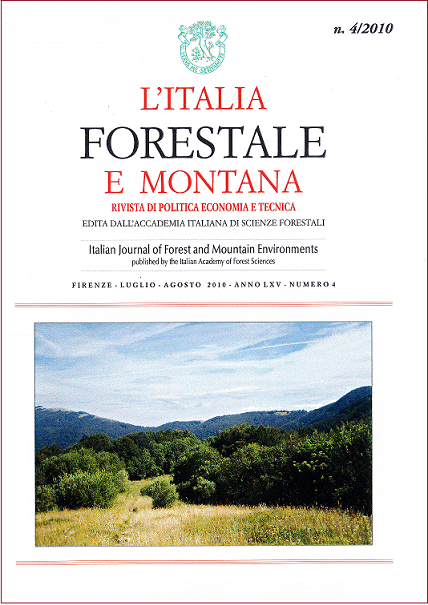Published 2013-05-15
Keywords
- complexity,
- biodiversity,
- global change,
- sustainability science
Copyright (c) 2022 Italian Journal of Forest and Mountain Environments

This work is licensed under a Creative Commons Attribution-NonCommercial 4.0 International License.
Abstract
Sustainability is based on the complexity science. We are living in an enchanting intellectual period, extraordinary rich in our knowledge of the reality. The disciplinary boundaries that we indicated in our culture, are now always more weak. We continue to separate the single elements of our knowledge but now it is more important to considered,as it is possible, the reality in its complexity. Emergence, as pointed out by theoretical biologist STUART KAUFFMAN, is therefore a major part of the new scientific
worldview. The behavior of large and complex systems is not to be understood in terms of simple extrapolations of the properties of the elements that are their components.
At each level of complexity entirely new properties appear, and as the Physics Nobel Prize Winner, PHIL ANDERSON, wrote, the understanding of the new behaviors requires research which is fundamental in its nature as any other. This new approach at
our way of knowing the reality are very important for the sustainability, that is the
capacity to create, test and maintain adaptive capability, Sustainability analyzes the interactions of the Social-ecological systems, the relationship between the natural systems
and the social systems and it tries to find solutions to maintain these relationships at a dynamic and harmonic equilibrium.
Sustainability is based on the knowledge of our Earth System. Now we know well, thanks to the research of the Earth System Science, that humans, both in numbers
and in per capita exploitation of the Earth’s resources, is expanding with significant impact on the world’s ecosystems and natural resources. Scientists recognize the
central role of mankind in geology and ecology by proposing, as made by the Chemistry Nobel Prize Winner, PAUL CRUTZEN, to use the term Anthropocene for the current
geological period. Earth System dynamics are characterized by critical threshold and abrupt changes. Biodiversity is now in a very critical state, despite the official target to
reduce significantly the rate of the loss of the biodiversity within 2010, subscribed by the governments of all countries in 2002. In this year, declared by United Nations,
International Year of Biodiversity, the state of the world biodiversity is continuously declining as illustrated by several recent research and also by the last «Global Biodiversity
Outlook 3», published in 2010 by the Convention on Biological Diversity. Unfortunately, and this is a real paradox in our so-called «knowledge society», there is a
growing gap between research findings and economic and political commitments.
It is fundamental to link ecology and economy. Earth System Science are demonstrating that we are reaching the limits to our economic and material growth in respect to the existing biophysical limits of our Earth, as it was brilliantly demonstrated in the famous Club of the Rome’s report «Limits to Growth» in 1972. It is extremely necessary to have, in the policy and economics, new indicators of the progress of human
societies. For this purpose are very interesting all initiatives that are moving towards «beyond GDP». The recent report of the Commission on the Measurement of Economic
Performance and Social Progress led by Economics Nobel Prize Winners, JOSEPH SIGLITZ and AMARTYA SEN, made by French President, NICHOLAS SARKOZY, and the reports published by the TEEB (The Economics of Ecosystems and Biodiversity)
an international initiative started in 2007 in occasion of the G8 environment meeting in Potsdam, supported by United Nations Environment Programme and by several governments, are a very good basis for guiding the needed change.

